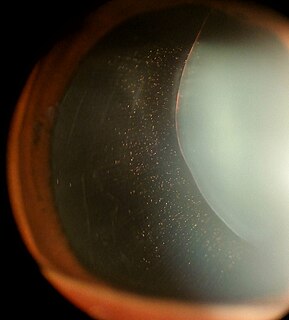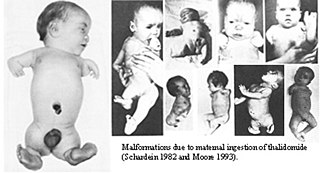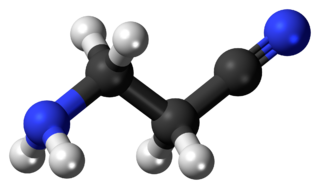Related Research Articles

A genetic disorder is a health problem caused by one or more abnormalities in the genome. It can be caused by a mutation in a single gene (monogenic) or multiple genes (polygenic) or by a chromosomal abnormality. Although polygenic disorders are the most common, the term is mostly used when discussing disorders with a single genetic cause, either in a gene or chromosome. The mutation responsible can occur spontaneously before embryonic development, or it can be inherited from two parents who are carriers of a faulty gene or from a parent with the disorder. When the genetic disorder is inherited from one or both parents, it is also classified as a hereditary disease. Some disorders are caused by a mutation on the X chromosome and have X-linked inheritance. Very few disorders are inherited on the Y chromosome or mitochondrial DNA.

Marfan syndrome (MFS) is a rare multi-systemic genetic disorder that affects the connective tissue. Those with the condition tend to be tall and thin, with long arms, legs, fingers, and toes. They also typically have overly-flexible joints and scoliosis. The most serious complications involve the heart and aorta, with an increased risk of mitral valve prolapse and aortic aneurysm. The lungs, eyes, bones, and the covering of the spinal cord are also commonly affected. The severity of the symptoms is variable.

Phocomelia is a condition that involves malformations of human arms and legs. Although many factors can cause phocomelia, the prominent roots come from the use of the drug thalidomide and from genetic inheritance.

Dwarfism describes a condition wherein an organism is exceptionally small, and mostly occurs in the animal kingdom. In humans, it is sometimes defined as an adult height of less than 147 centimetres, regardless of sex; the average adult height among people with dwarfism is 122 centimetres, although some individuals with dwarfism are slightly taller. Disproportionate dwarfism is characterized by either short limbs or a short torso. In cases of proportionate dwarfism, both the limbs and torso are unusually small. Intelligence is usually normal, and most have a nearly normal life expectancy. People with dwarfism can usually bear children, though there are additional risks to the mother and child dependent upon the underlying condition.

Homocystinuria or HCU is an inherited disorder of the metabolism of the amino acid methionine due to a deficiency of cystathionine beta synthase or methionine synthase. It is an inherited autosomal recessive trait, which means a child needs to inherit a copy of the defective gene from both parents to be affected. Symptoms of homocystinuria can also be caused by a deficiency of vitamins B6, B12, or folate.
Hypotonia is a state of low muscle tone, often involving reduced muscle strength. Hypotonia is not a specific medical disorder, but a potential manifestation of many different diseases and disorders that affect motor nerve control by the brain or muscle strength. Hypotonia is a lack of resistance to passive movement, whereas muscle weakness results in impaired active movement. Central hypotonia originates from the central nervous system, while peripheral hypotonia is related to problems within the spinal cord, peripheral nerves and/or skeletal muscles. Severe hypotonia in infancy is commonly known as floppy baby syndrome. Recognizing hypotonia, even in early infancy, is usually relatively straightforward, but diagnosing the underlying cause can be difficult and often unsuccessful. The long-term effects of hypotonia on a child's development and later life depend primarily on the severity of the muscle weakness and the nature of the cause. Some disorders have a specific treatment but the principal treatment for most hypotonia of idiopathic or neurologic cause is physical therapy and/or occupational therapy for remediation.

Arachnodactyly is a medical condition that is characterized by fingers and toes that are abnormally long and slender, in comparison to the palm of the hand and arch of the foot. In some cases, the thumbs of an individual with the condition are pulled inwards towards the palm. This condition is present at birth.

Antoine Bernard-Jean Marfan was a French paediatrician.
A connective tissue disease (collagenosis) is any disease that has the connective tissues of the body as a target of pathology. Connective tissue is any type of biological tissue with an extensive extracellular matrix that supports, binds together, and protects organs. These tissues form a framework, or matrix, for the body, and are composed of two major structural protein molecules: collagen and elastin. There are many different types of collagen protein in each of the body's tissues. Elastin has the capability of stretching and returning to its original length—like a spring or rubber band. Elastin is the major component of ligaments and skin. In patients with connective tissue disease, it is common for collagen and elastin to become injured by inflammation (ICT). Many connective tissue diseases feature abnormal immune system activity with inflammation in tissues as a result of an immune system that is directed against one's own body tissues (autoimmunity).

Hypermobility, also known as double-jointedness, describes joints that stretch farther than normal. For example, some hypermobile people can bend their thumbs backwards to their wrists, bend their knee joints backwards, put their leg behind the head or perform other contortionist "tricks". It can affect one or more joints throughout the body.

Loeys–Dietz syndrome (LDS) is an autosomal dominant genetic connective tissue disorder. It has features similar to Marfan syndrome and Ehlers–Danlos syndrome. The disorder is marked by aneurysms in the aorta, often in children, and the aorta may also undergo sudden dissection in the weakened layers of the wall of the aorta. Aneurysms and dissections also can occur in arteries other than the aorta. Because aneurysms in children tend to rupture early, children are at greater risk for dying if the syndrome is not identified. Surgery to repair aortic aneurysms is essential for treatment.

Dural ectasia is widening or ballooning of the dural sac surrounding the spinal cord. This usually occurs in the lumbosacral region, as this is where the cerebrospinal fluid pressure is greatest, but the spinal canal can be affected in any plane.

MASS syndrome is a medical disorder of the connective tissue similar to Marfan syndrome. MASS stands for: Mitral valve prolapse, Aortic root diameter at upper limits of normal for body size, Stretch marks of the skin, and Skeletal conditions similar to Marfan syndrome. It is caused by a mutation in the FBN1 gene, which encodes fibrillin-1. Fibrillin-1 is an extracellular matrix protein that is found in microfibrils; defects in the fibrillin-1 protein cause the malfunctioning of microfibrils, which results in improper stretching of ligaments, blood vessels, and skin.
Congenital contractural arachnodactyly (CCA), also known as Beals-Hecht syndrome, is a rare autosomal dominant congenital connective tissue disorder. As with Marfan syndrome, people with CCA typically have an arm span that is greater than their height and very long fingers and toes. However, Beals and Hecht discovered in 1972 that, unlike Marfan's, CCA is caused by mutations to the fibrillin-2 (FBN2) gene rather than the fibrillin-1 (FBN1) gene.

Aminopropionitrile, also known as β-aminopropionitrile (BAPN), is an organic compound with both amine and nitrile functional groups. It is a colourless liquid. The compound occurs naturally and is of interest in the biomedical community.
Marfanoid is a constellation of symptoms resembling those of Marfan syndrome, including long limbs, with an arm span that is at least 1.03 of the height of the individual, and a crowded oral maxilla, sometimes with a high arch in the palate, arachnodactyly, and hyperlaxity.

Genu recurvatum is a deformity in the knee joint, so that the knee bends backwards. In this deformity, excessive extension occurs in the tibiofemoral joint. Genu recurvatum is also called knee hyperextension and back knee. This deformity is more common in women and people with familial ligamentous laxity. Hyperextension of the knee may be mild, moderate or severe.

Elizabeth Anne Velásquez is an American motivational speaker, activist, author, and YouTuber. She was born with an extremely rare congenital disease called Marfanoid–progeroid–lipodystrophy syndrome that, among other symptoms, prevents her from accumulating body fat and gaining weight. Her conditions resulted in bullying during her childhood. During her teenage years, she faced cyberbullying, which ultimately inspired her to take up motivational speaking.
The Marfan Foundation is a non-profit organization in the United States established to raise awareness and promote research on treatment of Marfan syndrome and related disorders. The Foundation provides information about Marfan syndrome and funds research for the purposes of saving lives and improving the quality of life for people affected by the condition which is a genetic connective tissue disorder. The Foundation also lobbies Congress to fund Marfan syndrome research and engages in its own fundraising activities.

Dolichonychia is a medical condition in which the nail beds of the fingers and toes are abnormally long and slender, specifically, a finger nail index of 1.30 or more, it is a common feature in people with connective tissue disorders, such as Ehlers–Danlos syndromes, Marfan syndrome, and hypohidrotic ectodermal dysplasia., it often appears alongside arachnodactyly and/or dolichostenomelia, which is the condition of having long and slender fingers and toes.
References
- ↑ Schachner, Lawrence A.; Hansen, Ronald C. (2011). Pediatric Dermatology E-Book. Elsevier Health Sciences. p. 401. ISBN 978-0723436652 . Retrieved 7 March 2018.
- ↑ Wright, Alan F. (1994). Molecular Genetics of Inherited Eye Disorders. CRC Press. p. 383. ISBN 9783718654932 . Retrieved 7 March 2018.